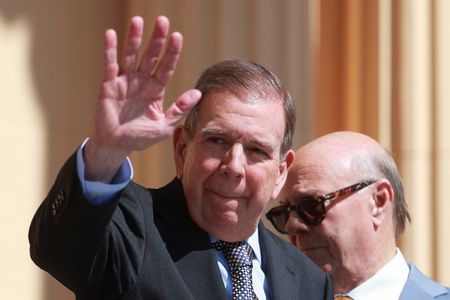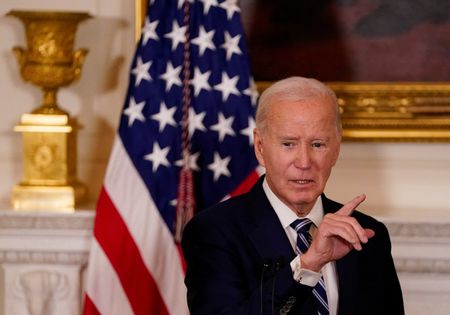By Tom Balmforth
MOSCOW (Reuters) – Russia’s deployment of tens of thousands of troops to the north, east and south of Ukraine is fuelling fears in Kyiv and Western capitals that Moscow is planning a new attack. Russia denies any such plans.
Western military analysts have suggested that Russia cannot keep such troops deployed where they are indefinitely due to financial and logistical issues and would need to pull them back by the summer of next year.
Estimates of the numbers of new Russian troops moved closer to Ukraine vary from 60,000-90,000, with a U.S. intelligence document suggesting that number could be ramped up to 175,000.
U.S. officials have warned Russia might launch a new attack against Ukraine as early as the second half of next month when the ground will be harder, making it easier for tanks and other armour to move swiftly.
President Vladimir Putin said on Thursday that Russian and U.S. officials would in January begin discussing Moscow’s proposals for security guarantees it wants from the West in order to defuse the current crisis and that he hoped for a positive outcome.
But what might a Russian attack actually look like and what could it seek to achieve?
“The current deployments are versatile. They keep Russia’s options open and therefore keep the defender guessing,” said Keir Giles, an Associate Fellow at Chatham House.
Here are some possible scenarios.
DONBASS ESCALATION
Heavily armed Russian-backed separatists have controlled a swath of eastern Ukraine since 2014 and continue to exchange fire with Ukrainian government forces on a regular basis despite a 2015 ceasefire that ended major hostilities.
The conflict in Donbass has killed 15,000 people, Kyiv says. Ukraine has long accused Russia of having regular troops in the region, something Moscow denies.
Russia in turn has accused Kyiv of harbouring plans to retake the region by force, something Ukraine denies.
In such a febrile atmosphere the risk of a misunderstanding or unplanned escalation is greater, and Russia could use such an incident as a casus belli.
One source familiar with the Russian Defence Ministry’s thinking said this was the most likely scenario if Moscow decided to attack, but said he was unaware of any such decision. Kyiv could also be provoked into attacking by the separatists who could then ask Russia to officially send in troops to help, the same source said.
Russian forces could expand the fighting in Donbass to draw Ukraine into a bloody, conventional conflict, said Neil Melvin, director of International Security Studies at RUSI. Moscow could try to seize new Ukrainian coastal areas on the Sea of Azov, creating a land bridge from the Russian city of Rostov through Donbass to Crimea, he said. “That would put the Ukrainian government under a lot of pressure,” he said.
ASSAULT FROM CRIMEA
Russia has brought in new forces to Crimea, which it annexed from Ukraine in 2014, and said this week paratroopers would be holding new drills there.
Moscow could launch a new attack on Ukraine from Crimea and seize territory up to the Dnieper River that could serve as a natural barrier against a potential Ukrainian counter-offensive, said Konrad Muzyka, director of the Poland-based Rochan consultancy.
The operation could begin with massive artillery, missile and air strikes on Ukrainian units in the south. Spetsnaz units might seize bridges and railway junctions, allowing troops and tanks to advance, he said. There are only two roads from Crimea that could be blocked or destroyed, a potential weakness, he said.
Forces would secure control of a Soviet-era canal that provided Crimea with fresh water supplies until Russia annexed the territory and Ukraine stopped the flow.
MULTI-FRONT ATTACK
A U.S. intelligence document made public this month said Russia could stage an invasion as soon as January with up to 100 battalion tactical groups (BTGs) or some 175,000 troops. It said about 50 BTGs were already in place to the north and east of Ukraine and in Crimea to the south, creating the possibility of an attack from three sides.
Seizing southern Ukraine could make military sense for Moscow by cutting Kyiv off from the coast and NATO’s presence in the Black Sea, Melvin said. Politically, it could play well with Russian nationalists who see the area as the historic “Novorossiya” lands or “New Russia”.
A multi-front assault might also involve a move into northeastern Ukraine, with Moscow encircling but perhaps not entering major cities where it could get bogged down in urban fighting. Equally, Russian troops could move into Belarus, opening up a northern front for Ukraine that would put Russian forces closer to Kyiv, Giles said.
“This of course would be the most costly economically, politically and in terms of human lives and that’s probably why it’s least likely,” Melvin said of an all-out invasion.
Analysts said even if it overwhelmed Ukraine’s army, which is half the size of its own, Russia could face guerrilla-type resistance that would make it hard to hold on to captured territory.
MISSILE STRIKES OR CYBER-ATTACK
Giles said some scenarios could involve long-range missile attacks or cyber-attacks targeting critical infrastructure. Missile attacks would take advantage of Ukraine’s weaker anti-missile defences.
“The different scenarios for how exactly Russia might seek to persuade the West to meet its (security) demands by punishing Kyiv don’t even necessarily include a land incursion,” he said.
(Reporting by Tom Balmforth; editing by Nick Macfie)











